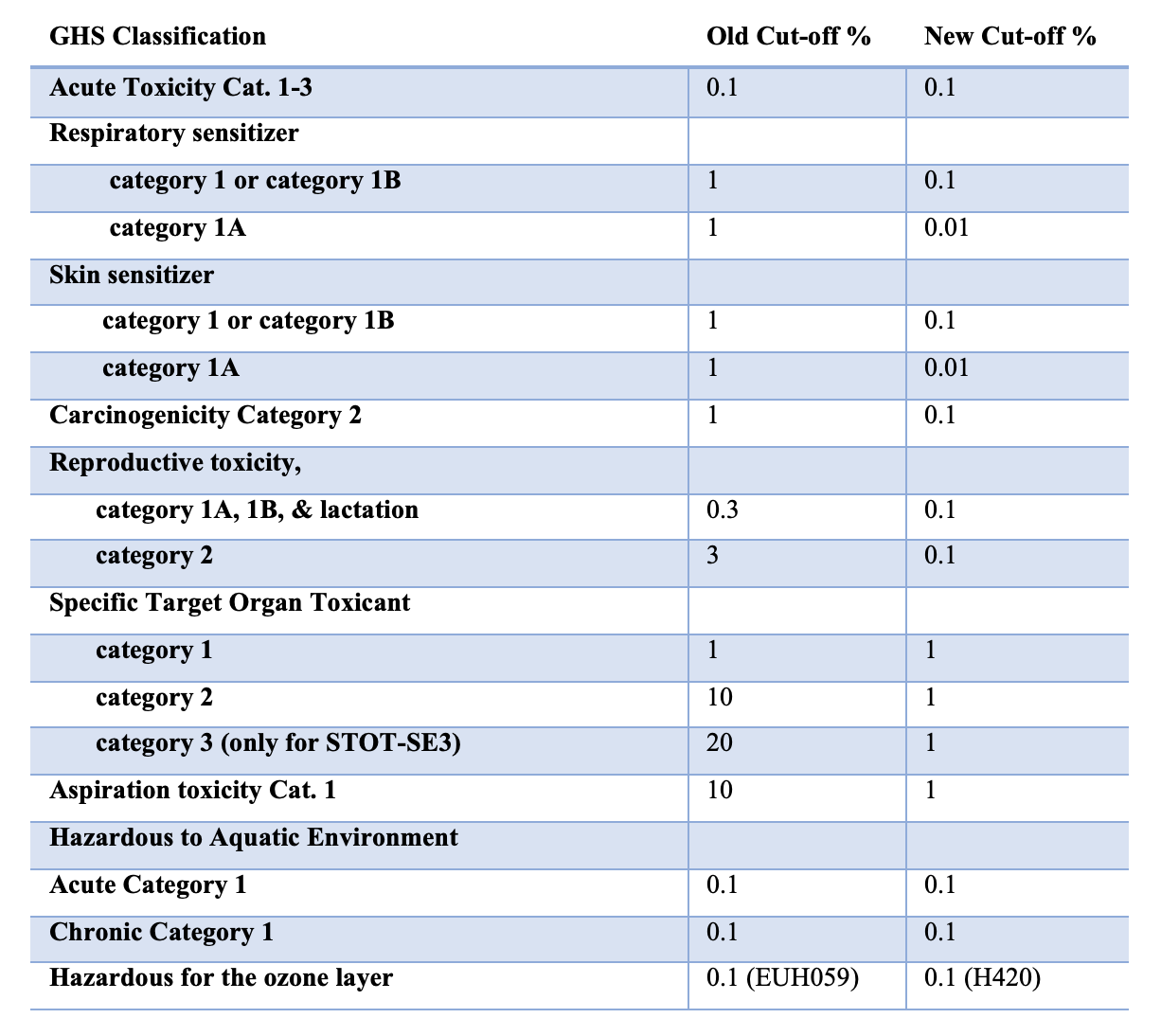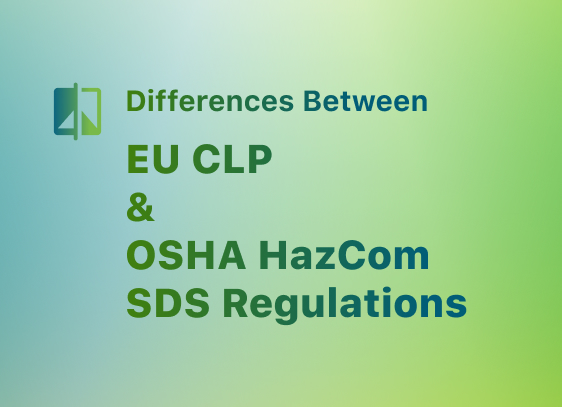
If you sell chemicals into the EU, there are many differences in the SDS regulations of which you need to be aware. Here are some of the regulations that are unique to the EU CLP SDS.
The majority of the SDS regulations require that all precautionary phrases tied to the GHS classifications be displayed on the SDS and label. However, the EU CLP requires that no more than 6 precautionary phrases appear on the SDS and label. The published guidelines for precautionary phrases priority can be found here: https://echa.europa.eu/documents/10162/2324906/clp_labelling_en.pdf
CLP has adopted official harmonized classifications for many chemicals, these have been published in the periodic CLP updates called ATPs (“Adaptation to Technical Progress”). If your SDS contains one of these chemicals, you must use the official classification for the chemical.
The ATPs include not only harmonized GHS classifications, but also notes. The notes are often exceptions to the GHS classifications, for example:
Note J:
The harmonized classification as a carcinogen or mutagen applies unless it can be shown that the substance contains less than 0.1 % w/w benzene (Einecs No 200-753-7), in which case a classification in accordance with Title II of this Regulation shall be performed also for those hazard classes.
The ATPs also include M Factors (multiplication) for certain aquatic toxins. For especially toxic chemicals an M factor of 10, 100, 1000 or 10000 may be assigned to a chemical. This will trigger the aquatic toxin at a level much lower than normal (0.1, 0.001, etc.).
For example, the chemical ‘fenoxycarb (ISO); ethyl [2-(4-phenoxyphenoxy)ethyl]carbamate’ CAS Number 72490-01-8 has an Aquatic Chronic M factor of 10,000. If this chemical’s concentration is above 0.0025%, the product will trigger H410 Aquatic Chronic 1.
Certain chemicals will also have “Specific Concentration Limits” (SCL), which are exceptions to the standard GHS concentration limits. For example, the chemical “isoeugenol” CAS Number 97-54-1 has a specific concentration limit of “Skin Sensitizer1A; H317: C ≥ 0.01 % “. This means that the product will be classified as Skin Sensitizer 1 at 0.01% instead of the standard CLP cutoff of 0.1%.
Here are CLP issues specific to sections of the SDS.
Section 1
Europe has implemented a poison control regulation which requires each product with hazardous mixtures to have a “Unique Formula Identifier” or UFI. The UFI code must be included in Section 1 of the SDS for your product. Tools and support to generate the UFI are available on ECHA’s Poison Centers website (https://poisoncentres.echa.europa.eu/).
If the product pertains to one or more nanoforms, the product description in Section 1 must contain the word “nanoform”.
Section 1.2 must now contain “relevant identified uses of the substance or mixture and uses advised against”.
Section 2
The new regulations require that any endocrine disruptors (in accordance with Article 59(1)) that appear in the product at 0.1% and above are listed in Section 2.3 of the product’s SDS.
Section 3
Section 3 must disclose the GHS Classifications of the chemicals in the product.
In Section 3, make note of any nanoforms, and extra data needs to be disclosed in section 9 and 12 and display the M Factors, cut-offs and ATE values that are listed in the regulation’s Part 3 of Annex VI to Regulation (EC) No 1272/2008.
Additionally, several new classifications of generic cut-off values are introduced in the updated SDS requirements. Any chemical with one of these classifications that are above the cut-off must appear in section 3.
Aquatic Toxins must be disclosed at (0.1/ M-factor )%, for example, if the chemical has an M factor of 10, it must be disclosed on section 3 at or above 0.01%.
Skin and Respiratory sensitizers with a specific concentration limit (SCL) must be disclosed on the SDS at or above a percentage of (SCL / 10).
Endocrine disruptors at or above 0.1% must also be included in Section 3
Refer to the table below for the list of the cut-offs that are unique to the EU or have changed due to the update. NOTE: this does not change the classification concentration limits, just those for inclusion in section 3.

Section 9
Appearance has been split into two categories: Physical State and Color.
Odor Threshold should be listed in the ‘Odor’ field.
Melting Point:
- Melting point and freezing point need to be indicated at standard pressure.
- If the melting point is above the measuring range of the method, it must be indicated up to which temperature no melting point was observed.
- If decomposition or sublimation occur prior to or during melting, it must be indicated. In regards to waxes and pastes, the softening point/range may be indicated instead of the melting point and freezing point.
- As for mixtures, if it is technically not possible to determine the melting point/freezing point, this needs to be indicated.
Boiling point or initial boiling point and boiling range
- These properties should be indicated at standard pressure. A boiling point at lower pressure might however be indicated, in case the boiling point is very high or in case decomposition occurs before boiling at standard pressure.
- If the boiling point is above the measuring range of the method, the temperature up to which no boiling point was observed must be indicated.
- If decomposition occurs prior to or during boiling, this must be indicated.
- For mixtures, if it is technically not possible to determine their boiling point or range, this should be indicated; in that case, the boiling point of the lowest boiling ingredient should also be indicated.
Lower and upper explosion limit: In regards to flammable liquids, at least the lower explosion limit must be indicated.
Flash Point:
- Does not apply to gases, aerosols and solids.
- For mixtures, a value for the mixture must be indicated, if available. Otherwise, the flash point(s) of the substance(s) with the lowest flash point(s) should be indicated.
Auto-ignition temperature:
- Only applies to gases and liquids.
- For mixtures, the auto-ignition temperature for the mixture must be indicated, if available. If the value for the mixture is not available, the auto-ignition temperature(s) of the ingredients with the lowest auto-ignition temperature(s) should be indicated.
Decomposition temperature:
- Only applies to self-reactive substances and mixtures, organic peroxides, and other substances and mixtures that may decompose.
- The self-accelerating decomposition temperature (SADT) and the volume to which it applies, or the decomposition onset temperature must be indicated.
- It must be indicated whether the temperature given is the SADT or the decomposition onset temperature.
- If no decomposition was observed, it should be indicated up to which temperature no decomposition was observed, e.g. “no decomposition observed up to x °C”.
pH:
- Does not apply to gases.
- The pH of the substance or mixture as supplied, or where the product is a solid, the pH of an aqueous liquid or solution at a given concentration, must be indicated.
- The concentration of the test substance or mixture in water needs to be indicated.
Kinematic viscosity:
- Only applies to liquids.
- The measurement unit must be mm2/s (centistokes).
- For non-Newtonian liquids, the thixotropic or rheopexy behavior must be indicated.
Solubility:
- Solubility must generally be indicated at standard temperature.
- The solubility in water must be indicated.
- The solubility in other polar and non-polar solvents should also be included.
- In regards to mixtures, it must be indicated if the mixture is fully or only partially soluble in or miscible with water or other solvent.
- In regards to nanoforms, the dissolution rate in water or in other relevant biological or environmental media must be indicated in addition to the water solubility.
Partition coefficient n-octanol/water (log value):
- Does not apply to inorganic and ionic liquids and does not generally apply to mixtures.
- It should be indicated whether the reported value is based on testing or on calculation.
- In regards to nanoforms of a substance for which the n-octanol/water partition coefficient does not apply, the dispersion stability in different media must be indicated.
Vapor pressure:
- Vapor pressure should generally be indicated at standard temperature.
- In regards to volatile fluids, the vapor pressure at 50 °C must also be indicated.
- In cases where one safety data sheet is used to cover variants of a liquid mixture or liquefied gas mixture, a range for the vapor pressure should be indicated.
- In regards to liquid mixtures or liquefied gas mixtures, a range for the vapor pressure or at least the vapor pressure of the most volatile ingredient(s), where the vapor pressure of the mixture is predominantly determined by that or those ingredient(s), must be indicated.
- The saturated vapor concentration may also be indicated.
Density and/or relative density:
- Only apply to liquids and solids.
- Density and relative density should generally be indicated at standard conditions of temperature and pressure.
- The absolute density and/or the relative density based on water at 4 °C as reference (also referred to as the specific gravity) must be indicated.
- In cases where variations in density are possible, e.g. due to batch manufacture, or where one safety data sheet is used to cover several variants of a substance or mixture, a range may be indicated.
- The safety data sheet must indicate whether the absolute density (units e.g. g/cm3 or kg/m3) and/or the relative density (dimensionless) is being reported.
Relative vapor density:
- Only applies to gases and liquids.
- In regards to gases, the relative density of the gas based on air at 20 °C as reference must be indicated.
- In regards to liquids, the relative vapor density based on air at 20 °C as reference must be indicated.
- In regards to liquids, the relative density Dm of the vapor/air-mixture at 20 °C may also be indicated.
Particle characteristics: (Note: this is a new sub-heading)
- Only apply to solids.
- The particle size (median equivalent diameter, method of calculation of the diameter {number-, surface- or volume-based} and the range in which this median value varies), must be indicated. Other properties may also be indicated, such as size distribution (e.g. as a range), shape and aspect ratio, aggregation and agglomeration state, specific surface area and dustiness. If the substance is in nanoform or if the mixture supplied contains a nanoform, those characteristics should be indicated in this subsection, or referred to if already specified elsewhere in the safety data sheet.
Section 9.2.1 now must contain information regarding physical hazards (such as explosive properties or metals that are corroded by the substance or mixture).
Section 9.2.2 also must contain other safety characteristics such as mechanical sensitivity or conductivity properties.
Section 11
Section 11.1 should now be titled “Information on hazard classes as defined in Regulation (EC) No 1272/2008”.
In a new sub section, 11.2.1, endocrine disrupting properties must be included.
Section 12
Section 12.6 is now “Endocrine disrupting properties”, and Section 12.7 is now “Other adverse effects”.
For the original text of the Regulation EU 2020/878, refer to https://eur-lex.europa.eu/legal-content/EN/TXT/PDF/?uri=CELEX:32020R0878&from=EN.







